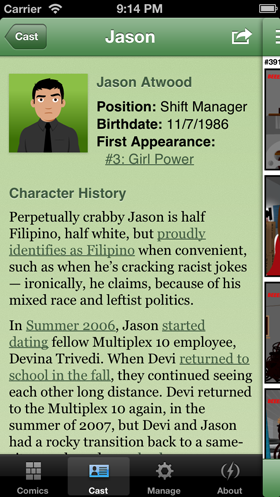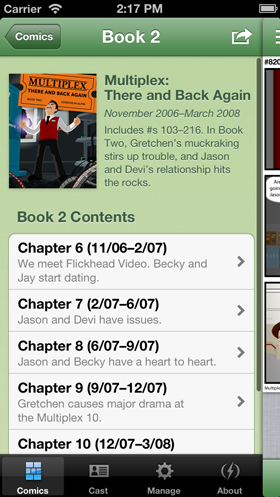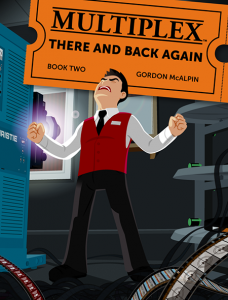“As soon as the iPad was rumoured, I wanted a Multiplex app” web comic creator Gordon McAlpin on turning Multiplex webcomic into an iOS app
 Mixing the world of comics, iOS apps and movie snobbery, Multiplex webcomic is the brain child of comic artist Gordon McAlpin and sees his hit webcomic released on the iTunes Store as an iPhone app so you can read the adventures of his movie loving dup Kurt and Jason wherever and whenever you are. Keen to find out more about this innovative approach to self publishing we contacted Gordon to get the lowdown on the secrets to being an app-based digital comic publisher and also the correct etiquette for movie going.
Mixing the world of comics, iOS apps and movie snobbery, Multiplex webcomic is the brain child of comic artist Gordon McAlpin and sees his hit webcomic released on the iTunes Store as an iPhone app so you can read the adventures of his movie loving dup Kurt and Jason wherever and whenever you are. Keen to find out more about this innovative approach to self publishing we contacted Gordon to get the lowdown on the secrets to being an app-based digital comic publisher and also the correct etiquette for movie going.
Tell us a bit about where the inspiration for Multiplex webcomic came from? Have you worked in a movie theatre or are you just a big movie fan and saw people like Kurt and Jason?
GM: Like a lot of ideas, Multiplex gestated for a long time. A buddy of mine, Kurt Bollinger, had worked at a movie theater for several years, and one night in my early twenties, I was complaining that I wanted to draw a comic about something but couldn’t come up with a story I wanted to tell. He suggested I do something about a movie theater. At the time, I was in an “epic-length graphic novel” mindset, and I couldn’t imagine how to do something in that format about a movie theater, so I dismissed it, saying, “Nah, that’d be stupid.”
A few years later, I had totally forgotten he’d suggested it to me and came up with the idea of doing an animated web short called Multiplex, but I never managed to learn Flash, and the script never really came together, so I put it back to bed.
A few more years later, I was about to launch a website for Stripped Books, a non-fiction comic strip adapting book-related events (author appearances, a book launch party, that kind of thing) into comics. I had done a handful of them for Bookslut.com, but I took it to its own website for a variety of reasons…
In addition to keeping things more timely, I wanted to have a more regularly updating “back-up” feature to keep people coming back more often. I immediately realised Multiplex was perfect for that. It didn’t need to be an ongoing story. Timeliness was key here, too: I could watch a movie or see a trailer, do a strip about it, and post it online in less than 24 hours. You can’t do that in print. Even Doonesbury has a lead time of ten days, which is insanely fast compared to most newspaper comics. That’s old news in the movie business!
Soon after Multiplex launched, it became way more popular than Stripped Books. Amusingly, Multiplex has since evolved into an ongoing narrative, of sorts — sort of a hybrid between a comic strip and a serialized graphic novel. There is (now) an overall arc to the whole series, which will wrap up in a few years. So my obsession with epic narratives prevailed in the end.
Is any of it based on real life or do you have friends who are like the main characters?
GM: Kurt in the comic strip is very loosely on Kurt in real life, Melissa is very loosely based on his girlfriend at the time, and Jason is very loosely based on myself in my twenties — but ultimately, all of the characters are me, especially the unlikeable ones. It’s not an autobiographical strip at all (I’ve never worked at a movie theater), but bits and pieces — sometimes large ones — are inspired by or stolen from my life and other peoples’ lives, chucked in a blender, and then (hopefully) transformed into something interesting or funny.
 How do you think it has grown and developed over the 8 years since it launched as a web comic and what would you have liked to change or improve about it given the chance? Is there any key advice you could give to other web comic creators?
How do you think it has grown and developed over the 8 years since it launched as a web comic and what would you have liked to change or improve about it given the chance? Is there any key advice you could give to other web comic creators?
GM: When Multiplex launched back in July, 2005, I was just making it all up as I went along. And that worked for me at the time. In college, I would constantly cook up these epic graphic novel ideas and then get sick of the story after writing a hundred pages of notes, never having drawn a single page of it. Or I’d get twenty pages in. Or eight pages. By doing a comic strip and not having any trajectory in mind for it at first, I was freed from all of that. My goals were much more manageable, bite-sized chunks — particularly given my short attention span and limited free time. That’s how I’d suggest most cartoonists start out: do short stories or jokes, even if you don’t think you’re funny. Knowing how to tell a joke in four or six panels helps you craft tighter, more cohesive stories. Even when those stories get to be a hundred pages long, you’ll make every page counted for something.
Once the strip gravitated toward book-length arcs in Book Four or so, that didn’t work as well anymore. I still work fairly improvisationally, but there are a few points that I wish I’d plotted out a little more tightly. That’s one of the disadvantages of doing a story comic in this format: you’re basically publishing your first draft.
These days, when I go back and re-read the strip, mostly I just wish the art were better early on. Multiplex is drawn in Adobe Illustrator, and at first I drew the strip with a paper cut-out approach. (The first strip is very South Park, art-wise.) It has moved pretty far away from that over the years. It’s more detailed and less locked into the rigid panel layouts that I stuck to for many of the earlier years. I’m able to manipulate color more easily and draw more naturally thanks to the suite of Illustrator plug-ins by Astute Graphics and various new features added to Illustrator over the last eight years.
For the collected editions — both in print and in the Chapter eBooks — I smooth over some rough patches in the narrative (and flesh out the characters) by adding bonus comics, and I sometimes fix the art in older strips. I try to not go full-on George Lucas on it and add, like, CG dewbacks to my early strips, but if there’s a continuity error or a really distracting tangent, then I’ll tweak it a little when I get to that stuff for the collection.
On very rare occasions, I’ll go back and change something on the website, like a glaring continuity error or something like that, but mostly I try to leave the old strips intact. (Recently, I introduced a character only to realize that I’d already mentioned — but not shown — him using a different name a few years before. So I got sneaky and changed his name in the older strip.)
If the stuff on the website is the theatrical release, the collected editions are my extended edition director’s cut.
 Tell us about where the idea for turning it into an app came from?
Tell us about where the idea for turning it into an app came from?
GM: Almost as soon as the iPad was rumored to be a thing, I wanted a Multiplex app. The potential of a “big iPod touch” in terms of interface and the possibilities that larger size opens up was just so obvious. But the idea of reading comics anywhere was not nearly as cool as the kinds of interfaces you can build around them.
I used to work as a print production artist for a living. I was a book designer for a couple of years, and I never really cared much about the web as a delivery medium for comics — yes, despite the fact that I do a webcomic. I was a print guy. Who really likes sitting at a desk to read? I sure don’t. And print always looked better. Yet as Comixology proved, tablets are wonderful comics readers — even moreso on retina display iPads. 300+ dpi screens plus RGB’s wider color gamut? Yes, please!
So between developing the Multiplex website over the last eight years and seeing the development in mobile technology since the iPhone, I’ve become much, much more interested in interactive design. So much so that I’m currently in grad school getting an MFA in Graphic Design (Interactive Design track) from the University of Minnesota now. I am decidedly a designer, not a programmer, though. I know HTML and CSS well enough, but I need help for the complicated stuff.
 Why an app and not simply publish digitally via ComiXology or an equivalent? And how did you get involved with your iOS developer?
Why an app and not simply publish digitally via ComiXology or an equivalent? And how did you get involved with your iOS developer?
GM: eBooks are still basically just for static content — a fixed, finite story or set of strips. For a comic strip that updates twice a week, you need something else. You need a website. For those of us who don’t like to read at our desks, mobile/touch-optimized websites are great — but native applications can be so much faster and have much better user interfaces. And with the new iPhone app, I can put the latest comic in it and it’s right there when you open the app. I can update the Cast pages on the website, it updates the API, and that data is available in the app.
The first version of the app was programmed by my brother Lawrence, who also coded the current version of my website, based on my designs. He built it using the MonoTouch development kit (now called Xamarin.iOS), which seemed like a good idea at the time, but every so often, Apple releases an iOS update that breaks compatibility with it, so it was a lot more work to maintain than if it were programmed natively. Lawrence updated it when there were breaking changes, but he has two awesome young daughters now, so working for me for peanuts was low on his priority list. I needed a new programmer if I wanted to do the iPad version or otherwise improve the app.
 I first became acquainted with Jelly — a.k.a. Daniel Farrelly — when he did a guest strip for Multiplex a few years ago. Earlier this year, though, I’d mentioned on Twitter that my brother no longer had time to work on the app. Jelly still reads the comic and follows me on Twitter, and he replied that he was interested in taking over development of the app. (He’s a freelance developer when he’s not slumming it with me.) So I whipped up some mock-ups, and he tore them apart and made some fantastic suggestions, and we went back and forth like that for the past few months until it was ready for beta testing.
I first became acquainted with Jelly — a.k.a. Daniel Farrelly — when he did a guest strip for Multiplex a few years ago. Earlier this year, though, I’d mentioned on Twitter that my brother no longer had time to work on the app. Jelly still reads the comic and follows me on Twitter, and he replied that he was interested in taking over development of the app. (He’s a freelance developer when he’s not slumming it with me.) So I whipped up some mock-ups, and he tore them apart and made some fantastic suggestions, and we went back and forth like that for the past few months until it was ready for beta testing.
On the subject of the eBooks, though, I submitted my first eBook to ComiXology, but they rejected it, because the way I use film stills and movie posters is copyright infringement. I feel like it’s fair use, and I have never had a complaint from any movie studios, some of whom I’m signed up with as “press.” We’re basically at an impasse on that point, so it’s not available through ComiXology. You only need to recall the Saga #12 debacle to know that Comixology is, perhaps, a little overzealous about things like this, but I can’t blame them for it. I just think they’re wrong.
Besides, between Apple and ComiXology‘s cuts, I would make about 70¢ per $1.99 comic. One of the next things on our app to-do list is adding the ability to buy and read the Chapter eBook collections in the app. With my own app, I’ll make twice that.
Would selling through ComiXology more than double my sales? Maybe. And I’d still love to sell them through it, in addition to selling them through my own app. But my PDF-format Chapter eBooks are a better format for Multiplex, anyway. The page heights vary in my PDFs, so strips aren’t broken up onto more than one page like they need to be for the print book. The art is preserved as vectors, so except for things like movie posters and film stills, you can blow it up as big as you want, and it’ll still look perfectly sharp.
What are the various pros and cons for releasing it as an iPhone version first? Do you think comics can succeed on a relatively small screen like the iPhone? Or does it depend on the type of comic (i.e. comic strips will do better than full blown superhero books?)
GM: Well, the main con is that it’s not the ideal size of screen to read Multiplex. Certainly, horizontal (“newspaper”-style) strips work better on tiny screens than page format comics like Multiplex or cape comics — but some people love reading them on their iPhones, you know? I may not, but roughly 10% of my website’s visitors are on phones. So yeah, I think there’s interest in it.
For my money, tablets are where the real potential is when it comes to mobile devices and comics. Since I have an Android phone, I use the iPhone app on my iPad mini, but I think it works great. The UI is oversized, as with all iPhone apps on the iPad, but pages are legible without zooming in. The app is a much better reading experience — and much faster — than opening the website in Mobile Safari.
The iPhone app with designed an eventual iPad (universal) app in mind, of course, but we didn’t just go straight to the iPad version for a couple of reasons. The main reason was that I already had the first version out there, and it was a little unstable after the last few iOS updates broke compatibility, so getting an update out as soon as possible was the most important thing. The new version is a complete rebuild in Objective C, meaning it’s much more stable (knock on wood), and less likely to get broken by iOS updates. It’s also a solid foundation upon which we can build our future additions, including the iPad interface.
The other thing was that… well, we can’t build a good iPad version yet, simply because retina-quality images don’t exist for it. My current strips on the website are a fixed 720px wide. Older strips are 600px wide. While that’s big enough to look good on an iPhone, it doesn’t look as good blown up to full size on a retina display. While Chapter eBooks look fantastic on retina iPads, only the first two years or so of the archives are collected at this point, because I need to create bonus comics for each of them. So adding in-app purchasing and reading of the Chapter eBooks, as we’re planning to do, is only a partial solution.
Until we get things set up to serve retina-quality images to the app (and to a reworked website), there’s no real advantage to having a retina iPad interface. A retina interface is sort of pointless if the content isn’t retina quality, you know? And doing that in a way that makes sense from a publishing standpoint is trickier than it sounds. We have some ideas for that, but it will take time to make sure it’s the best approach. In the meantime, the website is fine for tablets. Smartphones, not so much.
Reading the latest strip on the website from a smartphone isn’t a problem, but you’re not going to go on an archive dive while reading the full website on your iPhone. Tap, wait, zoom, pan pan pan pan… Tap, wait, zoom, pan pan pan pan… So that’s what the app is for. While we’re laying the groundwork for that iPad version, we can iron out the kinks with the API and the interface on the iPhone version. And by limiting ourself to the smaller screen first, we are more conscious of what features we really need at all, versus what’s nice to have. Cast pages? Must-have. Calendar-based search? Nice to have, but not essential.
It breaks down the development of the app (and the API and the website) into much more manageable chunks of work.
What’s your overall take on digital comics? Does it help self publishers like yourself? And how do you think Multiplex will manage in amongst the millions of other apps on the app store?
GM: Well, as a reader, I love them. I buy all my “monthly” comics digitally now. I still prefer trade paperbacks and hardcovers for the stuff I want to hang onto, but I no longer feel any need to fill up long boxes with comics I will likely never re-read and may not have liked in the first place.
As a cartoonist who works in Illustrator, the PDF format eBooks on a tablet, with a good reader, are my ideal format.
While Jelly and I have a long list of things planned to make the app even better, I think what we’ve done is create an app for Multiplex that no other webcomics reader or app has come close to: it’s fully integrated with the same custom API my website uses, but it takes advantage of features only native apps can do to create a wonderfully immersive reading experience. Of course, all of this depends pretty heavily on whether you actually like the comic in the first place!
As far as competing with other apps, that’s not something I really think about. Maybe a few people will discover Multiplex in the App Store and fall in love with it. I know one of our beta testers for the new version of the app discovered Multiplex that way. But I don’t really expect it will be a lot of people. Mostly, I think people will come at the app the other way around: finding out about the webcomic and then seeing there’s an app.
Basically, the app is one more way for people to remember the strip: “Oh, hey, there’s that icon of Kurt and Jason. I haven’t read Multiplex in a while. I should do that.” I just want people to read my comics, you know? Ultimately, I don’t care if it’s online or in an app or in the book; I just figure, if there’s a book for my comic, I want it to be the best book I can make. If there’s an app, I want it to be a great one.
 What would like the next step for Multiplex to be, both as a comic and as an app?
What would like the next step for Multiplex to be, both as a comic and as an app?
GM: The second print collection, Multiplex: There and Back Again, is way behind schedule but will be out this fall, I hope.
The webcomic is hurtling ever towards its ending in… well, I say about four years now, but who knows? It ends when I get to the ending. I’m planning to do nine books in all, and we’re in Book Seven now. After that, I won’t be totally done with Multiplex, though: I’ll be able to work on the collected editions more quickly after that.
With the app, we’re working towards an iPad version, but as I mentioned earlier, there’s a lot to do before we can make that happen. We want to add in-app purchasing of the Chapter eBooks, as I mentioned. We want to re-skin the app a bit to make it look more at home in iOS 7 when that comes out, which may or may not be a lot of work. And we have some other ideas that I want to keep secret for a little longer. haha
 And finally, when it comes to movie going, do you have any particular rules or habits that you try and adhere to and what do you think Kurt and Jason would make of those quirks?!
And finally, when it comes to movie going, do you have any particular rules or habits that you try and adhere to and what do you think Kurt and Jason would make of those quirks?!
GM: Heh. I always want to sit as close to the center of the theater as possible, from all sides. It’s the best spot! Otherwise, not really. You definitely don’t want to pull out a your blindingly bright smartphone during the movie near me, though. Very bad idea. Kurt and Jason are definitely on board with me there.
The Multiplex app is available to download from the iTunes Store here and for more information vists Gordon’s website at www.multiplexcomic.com





Multiplex: Deleted Scenes — Interview with Pipedream Comics
July 27, 2013 @ 7:26 am
[…] has been up for a couple of days, but I recently spoke with Alex Thomas of Pipedream Comics (“the ultimate guide to the world of digital comics”) about Multiplex, both the webcomic and […]
5 great iPhone digital comics apps (that aren't ComiXology) | Pipedream ComicsPipedream Comics
November 9, 2013 @ 9:15 am
[…] Read our exclusive interview with Multiplex creator Gordon McAlpin here […]
December 20, 2025 @ 10:10 pm
Diamond-Status für 50.000+ € Umsatz bietet
15% Cashback, Einladungen zu exklusiven Events in Deutschland und maßgeschneiderte Bonuspakete.
Gold-Status ab 5.000 € monatlichem Umsatz gewährt 10%
Cashback, Express-Auszahlungen innerhalb 2 Stunden und monatliche 200 € Geburtstagsbonus.
Silber-Status bei 1.500 € Umsatz bietet 7% Cashback, persönlichen Account Manager und wöchentliche 50 € Boni.
Unser fünfstufiges VIP-System belohnt deutsche Spieler basierend auf monatlicher Aktivität und
Umsatzvolumen.
Nach der Registrierung können Sie einen Willkommensbonus und Freispiele auf Ihre ersten Einzahlungen beanspruchen. Spieler erwartet eine riesige Auswahl mit
über 3.000 Slots, Live Casino, Tischspielen, Jackpots und exklusiven Neuerscheinungen von Top-Providern wie NetEnt, Play’n GO und
Evolution. Neukunden bei Cadoola Casino Österreich erhalten einen großzügigen Willkommensbonus von 500 € plus 200
Freispiele, verteilt auf die ersten Einzahlungen. Für bestehende Kunden gibt es Reload-Boni, Cashback, Freispiele und ein umfangreiches VIP-Programm.
Der Willkommensbonus ist sehr attraktiv und Free Spins gab
es gleich dazu – ein super Start für Einsteiger wie mich.
Deutsche Spieler erhalten 75% Bonus plus 50 Freispiele auf beliebten deutschen Spielautomaten wie
“Book of Dead” oder “Legacy of Dead”. Das wöchentliche Programm strukturiert sich nach deutschen Arbeitsmustern mit Wochenendbonus-Aktivierungen und werktäglichen Spezialaktionen. Unser
Bonussystem orientiert sich an deutschen Spielerpräferenzen und bietet strukturierte Belohnungen für neue und bestehende Kunden. Melden Sie
sich jetzt an und sichern Sie sich unser unglaubliches Willkommensbonuspaket von 800 EUR + 300 Freispielen!
Neukunden profitieren von einem Willkommenspaket
bis zu 500 € und 200 Freispielen. Cadoola Casino überzeugt Spieler in Österreich durch seine erstklassige Auswahl an Casinospielen, sichere Lizenzierung und eine benutzerfreundliche Webseite.
References:
https://online-spielhallen.de/ihr-zugang-zur-gaming-welt-lucky-dreams-casino-login/
December 26, 2025 @ 3:48 pm
They can include free spins, bonus credits, or even cash,
giving you a chance to try games and see how the casino works without risking your own money.
However, casino credits (or bonus money) generally offer more flexibility, allowing you to use them across a wider range of games.
New players can claim up to $3750 AUD and 250 free spins over their first
three deposits, with clear terms and a 35x wagering requirement.
These bonuses are designed to boost your playtime and
provide extra value, but they come with clear terms, such as wagering requirements and time limits.
We invest heavily in our security infrastructure so you can focus entirely on the
fun and excitement of the games, playing with the complete confidence that you are in a
safe and protected online environment.
From safety, Sign-up, Banking and Gaming, get answers to all frequently asked questions in online gaming.
With cut-throat competition in the market, the casinos strive hard to make their mobile casino one of the best.
Mobile casinos are the essence of online casinos nowadays.
Claiming this bonus, they can grab 100% match deposit bonus of
up to A$300 and 30 free spins.
In all other games, one Comp Point is awarded for every $200 wagered (or the
equivalent in other currencies). To advance to the next level,
you’ll need to collect Comp Points by placing real money bets
in any of their games. And, don’t forget to use the bonus code HIGH while depositing.
The wagering requirement for this bonus is, as always at Richard Casino, 40x your bonus
amount. This means a deposit of $5,000 triggers the maximum bonus.
References:
https://blackcoin.co/uptown-pokies-casino-a-comprehensive-review/
December 27, 2025 @ 7:55 am
There is no clutter, no second-guessing, just clean navigation and a focused layout that makes
play intuitive. Promotions rise naturally to your attention, while your balance and menu tools stay
within easy reach at all times. It is not hidden behind logins, it is
on the screen as part of the game’s appeal and trust.
Players can follow each jackpot’s growth and see when it
hits, offering both anticipation and accountability. We showcase active,
ticking jackpot pools on dedicated titles, from daily prize drops
to progressive slots with million-dollar ceilings.
Live dealer games provide a realistic casino experience, complete with professional
croupiers and real-time streaming. Experience the thrill of live dealer games at Lucky ones, where you
can enjoy high-quality streaming and interactive gameplay.
House to a host of gaming categories such as poker, bingo, slot machines and absence of table games,
the casino captivates with a commendable collection of 1200
gaming machines and two dedicated poker tables.
References:
https://blackcoin.co/rocketplay-casino-bonus-codes-november-2025/
December 29, 2025 @ 5:15 am
online real casino paypal
References:
we-cores.com
December 29, 2025 @ 5:38 am
paypal online casino
References:
https://trbs.link/barbraballinge